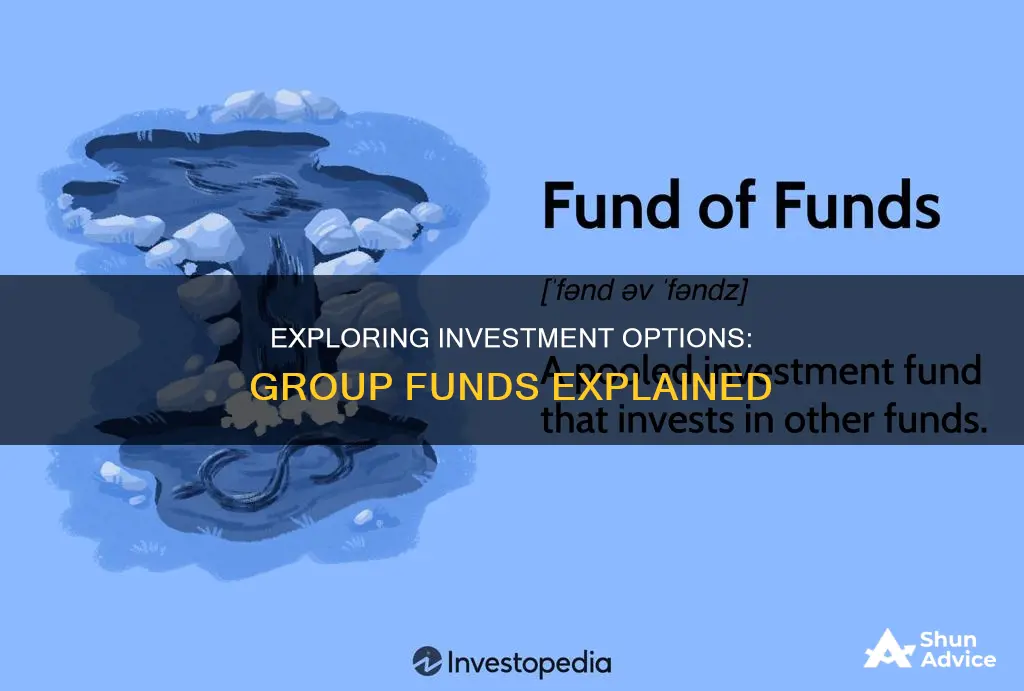
An investment group is a group of people who pool their funds to invest in various projects and assets. This allows individuals to benefit from the advantages of investing as a group, such as lower risk, more capital, and increased diversification. Investment groups can be formal or informal, and they can be structured as partnerships, limited liability companies, or corporations. The most common type of investment group is an investment club, which is typically a group of amateur investors who pool their money and resources to invest in the stock market, bonds, mutual funds, real estate, and other investments. Mutual funds are another type of investment group where money from multiple investors is pooled to purchase a diversified portfolio of stocks, bonds, or other securities.
| Characteristics | Values |
|---|---|
| Definition | A group of people who pool their funds to invest together |
| Participants | Professional investors, amateur investors, friends, family, customers, angel investors, etc. |
| Structure | Special purpose vehicle, crowdfunding, syndication, investment fund, multi-owner vehicle, partnership, limited liability company, corporation, etc. |
| Requirements | Age, valid Social Security number, financial needs, investment experience or knowledge, membership fee |
| Advantages | Lower risk, more capital, extended network, increased diversification, knowledge sharing, social environment |
| Disadvantages | Decisions may not be in the best interest of all members, disagreements among members, costly, complex, subject to regulations and taxes |

Mutual funds
There are different types of mutual funds, including stock funds, bond funds, money market funds, and target-date funds. Stock funds can be further categorized into growth funds, income funds, index funds, and sector funds. Growth funds focus on stocks with high financial gain potential, while income funds invest in stocks that pay regular dividends. Index funds track a specific market index, such as the S&P 500, and sector funds specialize in a particular industry segment. Bond funds aim for higher returns but carry higher risks, and money market funds invest in low-risk, short-term debt instruments. Target-date funds, also known as lifecycle funds, adjust their mix of stocks, bonds, and other investments over time, making them popular for retirement planning.
When investing in mutual funds, it is important to consider the associated fees and expenses, such as operating expense ratios, loads, and brokerage trading fees. These fees can impact the overall returns generated by the investment. Additionally, investors should carefully read the fund's prospectus, which contains information about investment objectives, risks, performance, and expenses, to make informed decisions.
Index Funds: Smart Savings or Risky Business?
You may want to see also

Investment clubs
An investment club is a group of people who pool their money to make investments. Usually, investment clubs are organized as partnerships, with members studying different investments and then making investment decisions together.
- Organize membership: Find candidates who want to actively participate and are trustworthy, open to performing research, and able to afford such activity.
- Choose an organizational structure: Decide on a leader and how they will be selected and succeeded. Determine how often the club will meet, and what its rules are.
- Choose a legal structure: The most common structure is a partnership. The club will need to get an Employer Identification Number (EIN) from the IRS.
- Decide on goals and objectives: Create an operational plan on how to achieve them. This should be a group effort to build a consensus.
TSP F Fund: A Smart Investment Move?
You may want to see also

Special purpose vehicles
SPVs are often used by professional investors to finance specific deals or scale into more deals with more investor capital. They are usually formed for a specific deal or series of deals, meaning that investors are not locked into long-term commitments.
SPVs are made up of a sponsor (the founder of the group), general partners, and limited partners. General partners help manage the SPV and are liable for its debts, while limited partners are silent or passive investors.
SPVs offer benefits such as transparency, short-term commitments, and insulation from risk. However, they can be expensive to set up and are subject to rules and regulations that may be challenging to navigate.
ETF and Index Funds: A Beginner's Guide to Investing
You may want to see also

Syndication
In addition to the leader, syndication involves a series of general partners and limited partners. General partners consist of parties like real estate developers, attorneys, architects, and other key professionals. Limited partners are passive investors who contribute capital toward the project.
There are several benefits to syndication. Firstly, it offers the opportunity to earn passive income. If you invest in an apartment building or a hotel, for example, the cash flow from that property can offer returns to all parties in the investment group. Syndication also offers a level of control that isn’t always available in group investing. Participating investors can choose which specific properties they want to contribute funds to.
However, syndication has its downsides. It is very targeted—real estate syndication is not suitable for forming an investment group capable of pursuing a wide range of investment opportunities. Setting up a real estate syndication can also be complicated and expensive. To start a real estate syndication, you need to be an accredited investor, which means having an annual income of at least $200k or a net worth over $1M. Syndications are also subject to SEC regulation.
Funding an Investment Farm: Strategies for Success
You may want to see also

Investment funds
There are many types of investment funds, including mutual funds, exchange-traded funds (ETFs), money market funds, and hedge funds.
With investment funds, individual investors do not make decisions about how a fund's assets should be invested. Instead, they choose a fund based on its goals, risks, fees, and other factors. A fund manager oversees the fund and decides which securities it should hold, in what quantities, and when the securities should be bought and sold.
The majority of investment fund assets belong to open-end mutual funds, which issue new shares as investors add money to the pool and retire shares as investors redeem them. These funds are typically priced just once at the end of the trading day.
On the other hand, closed-end funds trade more like stocks than open-end funds. Closed-end funds are managed investment funds that issue a fixed number of shares and trade on an exchange. While a net asset value (NAV) is calculated for the fund, it trades based on investor supply and demand and may trade at a premium or a discount to its NAV.
ETFs emerged as an alternative to mutual funds for traders who wanted more flexibility with their investment funds. ETFs trade on exchanges and are priced and available for trading throughout the business day. Many mutual funds have ETF counterparts.
Hedge funds are another type of investment fund that is distinct from mutual funds or ETFs. Hedge funds are actively managed funds made available to accredited investors. They face less federal regulation and can invest in a variety of asset classes using a wide range of strategies.
Corporate Bond Funds: Worthy Investment or Risky Business?
You may want to see also







